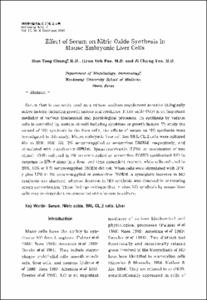Effect of Serum on Nitric Oxide Synthesis in Mouse Embryonic Liver Cells
- Journal Title
- Keimyung Medical Journal
- Issued Date
- 1998
- Keyword
- Serum; Nitric oxide; BNL CL.2 cells; Liver Introduction
- Abstract
- Serum that is commonly used as a culture medium supplement contains biologically active factors, including growth factors and cytokines. Nitric oxide (NO) is an important mediator of various biochemical and physiological processes. Its synthesis by various cells is controlled by various stimuli including cytokines or growth factors. To study the control of NO synthesis in the liver cells, the effects of serum on NO synthesis were investigated in this study. Mouse embryonic liver cell line BNL CL.2 cells were cultured 6hr in 20%, 10%, 5%, 2% serum-supplied or serum-free DMEM, respectively, and stimulated with interferon-Υ (IFN-Υ), lipopolysaccharide (LPS), or combination of two stimuli. Cells cultured in 2% serum-supplied or serum-free DMED synthesized NO in response to IFN-Υ alone in a dose- and time-dependent manner, while cells cultured in 20%, 10% or 5% serum-supplied DMEM did not. When cells were stimulated with IFN-Υ plus LPS in 2% serum-supplied or serum-free DMEM, a synergistic increase in NO synthesis was observed, whereas decrease in NO synthesis was observed in uncreasing serum concentration. These findings evidence that in vitro NO synthesis by mouse liver cells may be dependent on concentrations of serum in culture.
- Publisher
- Keimyung University School of Medicine
- Citation
- 정헌택 et al. (1998). Effect of Serum on Nitric Oxide Synthesis in Mouse Embryonic Liver Cells. Keimyung Medical Journal, 17(4), 459–466.
- Type
- Article
- Appears in Collections:
- 2. Keimyung Medical Journal (계명의대 학술지) > 1998
- 파일 목록
-
-
Download
 17-459.pdf
기타 데이터 / 380.3 kB / Adobe PDF
17-459.pdf
기타 데이터 / 380.3 kB / Adobe PDF
-
Items in Repository are protected by copyright, with all rights reserved, unless otherwise indicated.